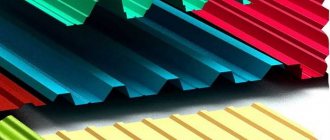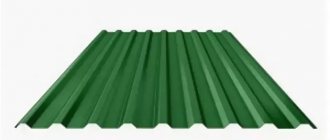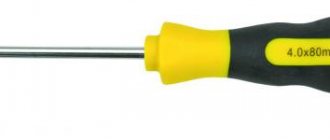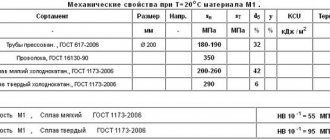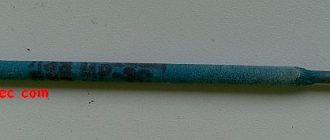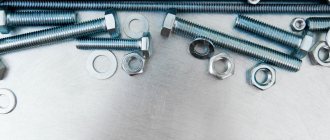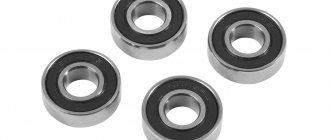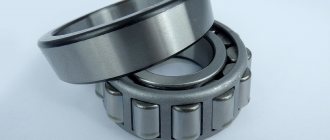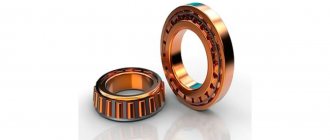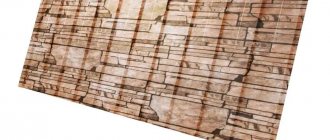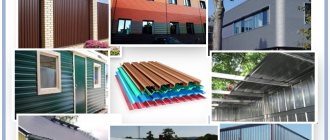Nowadays, very different brands of corrugated sheets are used for roofing and construction work.
And this is understandable, because profiled sheets, due to their simplicity and low cost of operation, are quite in demand on the building materials market.
Profiled sheets
But the variety of brands of corrugated sheets has another side - sometimes it’s very difficult to figure out which type is suitable for a particular task.
Below we will tell you how the designation applied by the manufacturer to a sheet of corrugated sheet is deciphered, and also what its especially popular brands are intended for.
What is a profiled sheet
Profiled sheet is a construction sheet material made from thin sheet steel. A relief is formed on the workpiece by cold stamping, and then a protective coating is applied. The relief is called a profile. This is where the name of the material came from - corrugated sheet. That is, a sheet with a profile. You can also find such a name as corrugated sheeting. Some people think that corrugated sheets and corrugated sheets are different materials and there is a difference between them. But no. No difference. It’s just that GOST describes two brands as “for flooring.” This is apparently where the name corrugated sheet came from.
“Bent steel sheet profiles with trapezoidal corrugations for construction” - name according to GOST 24045-2016. Conventionally, we can say that if it is necessary to cover the roof, we choose roofing profiles (corrugated sheeting), and if it is necessary to sheathe the walls, we choose wall profiles (corrugated sheeting).
In general, this material has many names. You can find a “sheet profile”, a metal profile. Less common is a “profile sheet”. There is also a name from the catalogs - profiled steel sheet. It's all about the same material.
This is what a corrugated sheet with a colored coating looks like
So, a profiled sheet is a steel sheet with a formed relief. A protective multilayer coating is applied to it. The number of layers and types of coatings differ and affect the final characteristics of the product. For durability, resistance to fading, high or low temperatures, chemical and mechanical influences. In general, many important properties depend on the coating and the quality of its application.
What is a professional sheet? This is sheet metal with a protective coating and a specially shaped profile
There are corrugated sheets for different purposes and they differ in relief. In the sense that the height and width of the wave, the distance between the peaks are different, and the shape is always trapezoidal. This is stated in GOST 24045-94. Only in some types (with increased load-bearing capacity) protrusions - shelves - are added on the side faces, and additional grooves are formed in the ridge and recess. However, the profile shape is trapezoidal.
Types of metal profiles
Profiled sheets, although they do not have such a variety of types as metal tiles, still, as they say, there is plenty to choose from.
Types of profiled sheets:
By type of decorative coating:
Galvanized - a profiled sheet of light gray metallic color without applying decorative colored coatings (often used for cladding the frame of prefabricated buildings, construction sheds, hangars, retail boxes).
Polymer – galvanized sheet with subsequent application of a colored (smooth, embossed, matte, glossy) decorative layer. This is the most common finishing option for profiled sheets. In this form, corrugated sheeting is used for fences and roofs in private housing construction. The material used to create various types of metal profile coatings is the same as for metal tiles (for detailed characteristics of the polymer layers of corrugated sheets, see here).
Printech is a type of polymer coating when a pattern imitating wood, stone, or brick is applied to a galvanized sheet using offset printing. This metal profile is used for fences and wall cladding.
Paint and varnish - instead of a polymer coating of corrugated sheets, a layer of paint 40-300 microns thick is applied. Painting a metal profile is the worst option, because... Periodically it is necessary to restore the paintwork. At the same time, if you paint the sheets with your own hands, you cannot achieve an even layer of equal thickness. In addition, peeling paint on a corrugated sheet looks unsightly.
By number of painted surfaces:
- Double-sided - decorative coating is applied to the front and back sides of the sheet. This metal profile is used for structures that can be viewed from both sides (fences).
- Single-sided - one side is tinted, the other is gray metallic. Such profiled sheets are purchased for cladding walls and roofs.
By purpose:
For fences and wall cladding (facade). Wall corrugated sheeting does not carry a special load, therefore it has a low profile height. For more information on which sheets you should buy for a fence, see here.
For the roof. A roofing metal profile differs from a wall profile in its greater rigidity (due to the need to withstand snow loads) and the method of longitudinal connection (overlapping). In addition, an anti-condensation coating can be applied to the inner surface of the roofing sheets. Read more about corrugated roofing here.
For loaded floors. Such sheets have the greatest rigidity due to their high profiles. They are made of metal with a thickness of 0.7-1.3 mm.
Also, corrugated sheets vary in size and thickness of the sheet, height and profile shape. Next, we will consider in detail the technical characteristics of profiled sheets.
Brands of corrugated sheets
Typically, corrugated sheets are made of sheet steel with zinc and aluminum-zinc coating. If they use an aluminum-zinc coating, they put AC in the marking, if they use zinc, they don’t put anything. If zinc is applied electrolytically, then EOTS is installed. The sheet can also be coated with a layer of aluminum (letters AL in the marking) or aluminum-silicon (AK). These coatings provide better protection, but are expensive.
Profiled steel sheet with a protective coating - this is corrugated sheeting
In addition to various “primary” coatings, rolled steel sheets are used in various thicknesses. In combination with different profiles, it has different load-bearing capacities, accordingly, it has different purposes and areas of application. According to their purpose, profiles are divided into types (GOST 24045-2016):
- N - for load-bearing covering decks that support the weight of the roof with insulation and the load of climatic influences;
- NS - for flooring and wall fences;
- C - for wall fences that perform load-bearing and enclosing functions.
Sometimes there is such a decoding of the designations of corrugated sheets, where type H is load-bearing (for load-bearing covering decks that bear the weight of the roof with insulation and the load of climatic influences). He is the heaviest, the toughest. Roofs with high snow and wind loads are made from this corrugated sheeting.
Brands of corrugated sheets and their purpose
NS - load-bearing wall. Another name is universal. Less “hardy”, but can be used on the roof with low loads on it. It is also possible to build load-bearing walls from it (with sufficient thickness and depth of the relief). He is often “allowed” onto fences that do not have crossbars between the posts.
C - wall profiled sheet. Used for cladding frame walls. It is used in the construction of garages from corrugated sheets and utility rooms. The same type, but of sufficient thickness, can be attached to the fence if there are crossbars between the posts. This material is not recommended for roofing. Unless there is almost no snow and wind. And then, the sheathing should be frequent, with small gaps.
Application area
Profiled sheet is a building material and is used as:
- roofing;
- facing wall;
- material for enclosing structures (fence, facade);
- formwork for the construction of monolithic reinforced concrete floors;
- sandwich panels.
The area of application of a specific profiled sheet is indicated by special markings:
- C - wall;
- N - bearing;
- NS - load-bearing wall;
- PC - corrugated roofing;
- MP - universal (for walls, roofs, sandwich panels);
- PG (“longitudinally bent”) - profiled sheets with this marking are used for the construction of arched structures, arched canopies, hangars.
You need to understand that the declared type of corrugated sheeting is just recommendations from the manufacturer. You must take into account the technical conditions of the facility where you will use the corrugated sheet, the conditions and service life. For example, if you are making a gazebo or a small extension to a house with continuous sheathing, then a simple C8 wall profile sheet will suit you. And if you need a high fence and there are strong winds in your area, then it would be better to use reinforced profiled sheeting.
Profiled sheet marking and its interpretation
The marking of corrugated sheets is also described in GOST. It contains all the necessary data, except weight. And so, there are all the sizes of the corrugated sheet, the name of the protective coating on both sides. But in order to read the transcript, you need to know in what position which symbols represent what. Appearance of the corrugated sheet markings in the figure.
How to decipher the markings of a profiled sheet and where its dimensions are indicated
The first position is the sheet type. It is stated in the previous paragraph: C - wall, NS - universal, N - for flooring. The specific scope of application is not indicated, but this information is usually provided by manufacturers.
Sheet dimensions and material
The second position will not raise many questions either. Here are the dimensions of the corrugated sheet in millimeters. Only the order of magnitude is unusual. First the height is indicated. This refers to the profile height. Then comes the width and thickness of the metal sheet. The length is not specified; it is usually discussed upon delivery, as it can vary within wide limits. For example, H44-1000-0.8. This is a load-bearing profile with a wave height of 44 mm, a sheet width of 1000 mm, made of a metal sheet 0.8 mm thick.
This type of profiled sheet is recommended for fences. Please note that the higher the profile height, the stiffer the fence will be. Well, the thickness of the sheet also plays a role.
In the third position there are letters by which you can determine the material of the workpiece. That is, what primary protective coating was applied to the metal sheet:
- If the steel is galvanized, it costs nothing.
- Electrolytic galvanization - EOTS.
- Aluminum-zinc coating - AC.
- Aluminum coating - AL.
- Aluminum ceramic - AK.
For example, N57-750-0.8 AL. Everything is clear with the dimensions of the corrugated sheet: sheet height 57 mm, width 750 mm, steel thickness 0.8 mm. The letters AL indicate aluminum coating. This is probably also understandable.
Paintwork
The fourth and fifth positions reflect the type of paint coating applied. All types of paints and primers that GOST allows are shown in the table. It also shows resistance to chemical attack depending on the type of primary protective coating on the metal.
| Name and designation of paint | Primer designation | Coating thickness in microns | Resistance to aggressive environments when applied to zinc coating | Resistance to aggressive environments when applied to aluminum-zinc coating | Resistance to aggressive environments when applied to aluminum coating |
| Without cover | non-aggressive | slightly aggressive with restrictions | slightly aggressive with restrictions | ||
| Enamel GF-2017 | 10-12 microns | non-aggressive | slightly aggressive with restrictions | slightly aggressive with restrictions | |
| Polyester silicone enamels ML-1202 | EP-0200 | 25-34 microns | slightly aggressive | slightly aggressive | slightly aggressive |
| Acrylic silicone enamels AS-1171, AS-5122 | EP-0200 | 25-30 microns | slightly aggressive | slightly aggressive | slightly aggressive |
| Organodisperse paints OD-HV-221 | AK-0138 | 40-50 microns | slightly aggressive | slightly aggressive | slightly aggressive |
| Epoxy primer EP-0140 | 70-80 microns | slightly aggressive | slightly aggressive | slightly aggressive | |
| Polyvinyl chloride plastic compounds PL_HV-122 | AK-0138 | 180-220 microns | slightly aggressive | non-aggressive with restrictions | non-aggressive with restrictions |
But the standard was developed a long time ago, and GOSTs are rarely updated. During this time, polymer coatings that were more reliable than paints appeared. Roughly speaking, polymer-coated corrugated sheets are not standard. But polymer-coated sheets are more resistant to fading, better withstand weather conditions and ultraviolet radiation, and are more resistant to mechanical stress. So that's not to say they're bad. Expensive. Yes. But in terms of performance characteristics it is better.
The coating cannot be determined by its appearance. You can only distinguish galvanized from painted
These other coatings can be:
- Pural. Designated PUR. High resistance to mechanical stress and abrasion.
- PVDF. Polyvinylidene fluoride. High resistance to ultraviolet radiation. Good for roofs.
- PVC (or PVC). Polyvinyl chloride. High degree of corrosion protection. Good in regions close to the sea.
- AC. Acrylic. The most inexpensive of polymer coatings. In relation to the above, it is inferior in resistance to fading and degree of protection.
In general, we examined the markings of the corrugated sheet and what it hides. The most interesting thing is that usually only the first two positions are indicated. For example, C 18-100-0.9, NS 44-100-0.6. The rest must either be looked at in the description or found out from sellers and dealers.
Comparison with other materials
It cannot be said that in all cases corrugated roofing is most suitable. Compared to other roofing materials, it has its pros and cons. When compared with soft rolled materials, profiled sheets are noticeably inferior in heat and sound insulation abilities, but superior in strength and durability. It is much easier to cover roofs with complex shapes and slopes with steep slopes using roll materials. Compared to conventional tiles, corrugated roofing is much lighter, faster and easier to install, much cheaper, but inferior in appearance and thermal insulation properties. Regular slate corrugated sheeting is superior in design, strength, and the prices are comparable. The closest material is metal tiles. It has similar disadvantages, but is more attractive in appearance and is reinforced with transverse ribs. At the same time, it is more expensive.
Sheet dimensions and weight
In general, enterprises produce profiled sheets not only in accordance with GOST, but also in accordance with technical specifications. Specifications are technical conditions in which the manufacturer sets down its dimensions and quality requirements. Registering them is not that difficult. But this is not GOST and anything can be there. If you see specifications on the labeling or in the accompanying documents, it is better to read it so that there are no surprises. And the standard does not have many profiles and sizes of corrugated sheets, which is why specifications are used. Consumers demand other sizes and profiles. The table shows the grades and sizes of corrugated sheets according to GOST, and the figure also includes drawings and appearance. By the way, sheet thickness with * is not a standard.
Drawing of the profiled sheet and appearance, sheet width and thickness
| Designation of profiled sheet | Width, mm | Metal thickness, mm | Weight of 1 meter long, kg | Weight per square meter, kg |
| N-75-750-0.7 | 750 | 0,7 | 7,4 | 9,8 |
| N75-750-0.8 | 750 | 0,8 | 8,4 | 11,2 |
| H75-750-0.9 | 750 | 0,9 | 9,3 | 12,5 |
| Н114-600-0.8 | 600 | 0,8 | 8,4 | 14,0 |
| Н114-600-0.9 | 600 | 0,9 | 9,3 | 15,6 |
| N114-600-1.0 | 600 | 1,0 | 10,3 | 17,2 |
| H114-750-0.8 | 750 | 0,8 | 9,4 | 12,5 |
| H114-750-0.9 | 750 | 0,9 | 10,5 | 14,0 |
| N114-750-1.0 | 750 | 1,0 | 11,7 | 15,4 |
| NS35-100-0.6 | 1000 | 0,6 | 6,4 | 6,4 |
| NS35-100-0.7 | 1000 | 0,7 | 7,4 | 7,4 |
| NS35-100-0.8 | 1000 | 0,8 | 8,4 | 8,4 |
| NS44-1000-0.7 | 1000 | 0,7 | 8,3 | 8,3 |
| NS44-1000-0.8 | 1000 | 0,8 | 9,4 | 9,4 |
| S10-899-0.6 | 918/899 | 0,6 | 5,1 | 5,7 |
| S10-899-0.7 | 918/899 | 0,7 | 5,9 | 6,6 |
| S10-1000-0.6 | 1022/1000 | 0,6 | 5,6 | 5,6 |
| S10-1000-0.7 | 1022/1000 | 0,7 | 6,5 | 6,5 |
| S18-1000-0.6 | 1023/1000 | 0,6 | 6,4 | 6,4 |
| S18-1000-0.7 | 1023/1000 | 0,7 | 7,4 | 7,4 |
| S15-800-0.6 | 940/800 | 0,6 | 6,5 | 6,0 |
| S15-800-07 | 940/800 | 0,7 | 6,55 | 6,9 |
| S15-1000-0.6 | 1018/1000 | 0,6 | 6,4 | 6,4 |
| S15-1000-0.7 | 1018/1000 | 0,7 | 7,4 | 7,4 |
| S21-1000-0.6 | 1000 | 0,6 | 6,4 | 6,4 |
| S21-1000-0.7 | 1000 | 0,7 | 7,4 | 7,4 |
| S44-1000-0.7 | 1000 | 0,6 | 7,4 | 7,4 |
Everything seems clear in the table. The dimensions of the profiled sheet are indicated in the same way as prescribed in the standard: profile height, sheet width and metal thickness. Length - by agreement or according to the manufacturer's capabilities. Questions may be where the width is indicated through a fraction. For example, 1022/1000. The first number is the full width when covering walls, the second is the working width when installing on the roof. As you understand, this is a dual-use material. Can be used both on the roof and for wall cladding.
For comparison, look at what sizes of corrugated sheets they can offer, and compare with what GOST prescribes
It is worth saying that if the parameters of a profiled sheet do not comply with GOST, this does not mean that the material is bad. You need to look at the quality of the coating and the rigidity of the sheet. In any case, it is worth finding reviews on the products of a specific manufacturer. Because standard ones can be made not so well. It's all about the quality of steel and coatings.
Criteria for selecting profile sheets
When choosing which corrugated sheeting to cover the roof with, pay attention to its markings. Not only the letter or numeric index is important, but also the GOST or TU marks
They mean compliance with government regulations, which are higher than those of manufacturing companies. There are other requirements that will help buyers how to choose corrugated sheets. Experts recommend focusing on:
- Appearance of profile sheets. Inspect the products. They should not have any defects - chips, peeling, paint runs.
- Geometric proportions of roofing material. The manufacturer must match the dimensions of the corrugated sheeting needed for your roof with the products he has available. Measurements of thickness, width and length according to GOST are a sign of a high-quality profile.
- Wave proportions. The corrugated sheets are arranged with an overlap, so the upper corrugation necessarily covers the lower one. Are you wondering what type of corrugated sheeting to choose for your roof? Purchase the required 20 cm of metal to ensure a high-quality overlap and reduce the risk of moisture getting on the roofing pie.
- Sheet cutting quality. At the factory, the metal profile is cut with a guillotine. Smooth and precise edges without nicks guarantee the absence of rust.
- Strength indicators. The round samples shown by the seller will not explain the strength of the material. Ask to demonstrate square samples.
- Sealing of packaging. If the profiled sheets are properly packaged, they will not be damaged during transportation.
Be sure to ask the supplier to issue a guarantee for the product and provide certificates of conformity. This will not only demonstrate the quality of the material, but also declare the responsibility of the selling company.
How to determine quality
First of all, an external inspection. The quality of application of paint, polymer or galvanization is the first indicator. There should be no sagging, drips or bald spots. GOST allows for abrasions and small scratches that do not damage the integrity of the protective layer. That is, if the scratch does not reach the metal, this is normal. This happens all the time during transportation. The main thing is that the coating is intact.
One of the indirect indicators of the quality of corrugated sheets is its weight. Reference values are indicated in GOST (available in the table). If the weight varies significantly downwards, this means that a thinner sheet or less dense (and cheaper) metal was used.
Direct evidence of the manufacturer’s reliability is the thickness of the sheet. If the declared thickness matches the actual one, this is a good sign. How to measure the thickness of a profiled sheet? Using an electronic caliper. Not such an expensive tool, but easier to use. If you have a regular one, you can take measurements using it. But keep in mind that the actual thickness - with a layer of paint or polymer - should be at least a little (several micrometers) greater than declared. This difference will be shown by an electronic device. A mechanical one will not cope with such a task.
Tips to help the buyer
Detailed familiarization with the nuances of material selection and its labeling is only part of the story. Practical recommendations from experienced roofers will help the future owner not to make a mistake in purchasing:
- Buy material for work from one supplier . Immediately calculate the consumption to purchase from one batch. So that you don’t have to search long and painfully for one sheet of corrugated tin of a similar tone and thickness.
- Purchase additional elements and fasteners together with the roofing . You can, of course, later in another store, but the shade may differ. If this was not included in the design, the effect may be completely unexpected.
- Pay attention to the integrity of the packaging . There shouldn't be any damage. It is possible that under the rupture there is already a microcrack in the polymer shell. This means that there is a possibility of a rust outbreak.
- Consider the sheets and additions . If you find the smallest scratches or abrasions, feel free to contact the seller for a replacement.
- Buy repair paint to match the corrugated coating . It will be useful during installation and after, if damage left by branches or vandals is detected. Do not buy spray paints.
It’s worth following the tips listed above if you don’t want to waste your money. If, of course, you have excess savings that you can easily part with, then you can ignore the recommendations presented.
Corrugated steel does not require any special maintenance techniques. Dust is washed off from its surface without delay during rains. The snow coming off the slopes does not leave scratches or streaks.
If persistent contamination is detected, it is recommended to wash the corrugated sheet with soapy water and wipe with a soft cloth.
